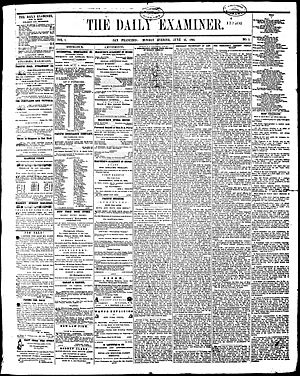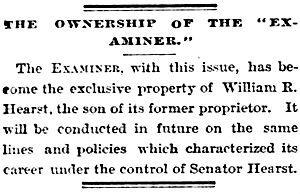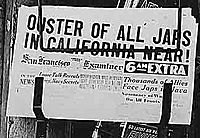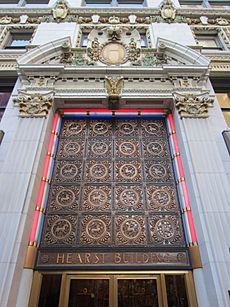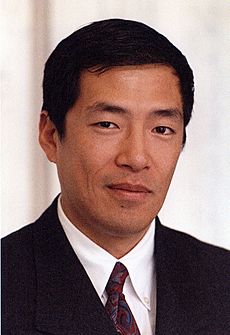San Francisco Examiner facts for kids
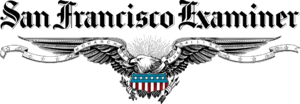 |
|
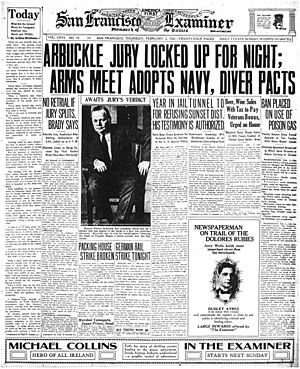
The front page from February 2, 1922
|
|
| Type | Newspaper |
|---|---|
| Format | Broadsheet |
| Owner(s) |
|
| Founded |
|
| Headquarters | 465 California St. Suite 1600 San Francisco, CA 94104 |
| ISSN | 2574-593X |
The San Francisco Examiner is a newspaper that has been published in San Francisco, California, since 1863.
A long time ago, its owner, William Randolph Hearst, called it the "Monarch of the Dailies." It was the most important paper in the Hearst family's large group of newspapers. Today, the Examiner is free for readers. It is owned by a company called Clint Reilly Communications.
Contents
History of the Examiner
How the Newspaper Began
The newspaper started in 1863 with the name Democratic Press. At that time, during the American Civil War, the paper supported the Confederacy and the Democratic Party. It was against President Abraham Lincoln.
After President Lincoln was assassinated in 1865, a crowd of angry people destroyed the newspaper's office. The paper soon started again with a new name. On June 12, 1865, it was published as The Daily Examiner.
The Hearst Family Takes Over
In 1880, a successful businessman named George Hearst bought the Examiner. Seven years later, he gave the newspaper to his 23-year-old son, William Randolph Hearst.
William Randolph Hearst wanted to make the paper exciting. He hired famous writers like Ambrose Bierce, Mark Twain, and Jack London. He also used a style called yellow journalism. This meant the paper printed dramatic, eye-catching stories that were sometimes exaggerated to attract more readers.
The paper became very popular. Hearst created a new logo with an eagle and the slogan Monarch of the Dailies.
Big Changes in the 20th Century
In 1906, a huge earthquake and fire destroyed much of San Francisco, including the Examiner building. For a short time, the Examiner worked with its competitors, the San Francisco Chronicle and the San Francisco Call, to publish a joint newspaper.
When the city was rebuilt, the Examiner moved into the new Hearst Building. For many years, it competed with other San Francisco papers. Over time, its main rival became the Chronicle.
In 1965, the two papers stopped competing so fiercely. They made a deal called a joint operating agreement. The Chronicle was sold in the morning, and the Examiner was sold in the afternoon. They worked together like this for 35 years.
A fun fact about the Examiner is that it always calls San Francisco "The City," with a capital C. This is a special tradition in both its headlines and stories.
The Examiner in Modern Times
New Owners and a New Style
In 2000, the Hearst company sold the Examiner to the Fang family, who were also in the newspaper business. Three years later, the Fangs made a big change: the Examiner became a free newspaper.
In 2004, the paper was sold again, this time to a company called Clarity Media Group. They created a new business model for the paper. It was printed in a smaller, compact size so it was easy to read quickly. It focused on local news, sports, and entertainment that was important to people in the San Francisco area.
The Newspaper Today
After a few more ownership changes, Clint Reilly Communications bought the Examiner in 2020. The new owners have continued to publish the paper, focusing on news for the San Francisco community.
Under new leadership, the paper brought back a larger, traditional newspaper format. It also started sending out news through email newsletters, a popular way people get information today.
Famous Staff Members
Many talented people have worked for the Examiner over the years.
- Herb Caen was a very popular columnist who wrote about life in San Francisco.
- Frank Herbert worked for the paper before he became famous for writing the science fiction novel Dune.
- David Talbot was an editor who later started the online magazine Salon.
- Ernest Thayer wrote a famous poem called "Casey at the Bat" while working as a columnist for the paper.
See also
 In Spanish: San Francisco Examiner para niños
In Spanish: San Francisco Examiner para niños
- San Francisco Chronicle
- San Francisco newspaper strike of 1994


